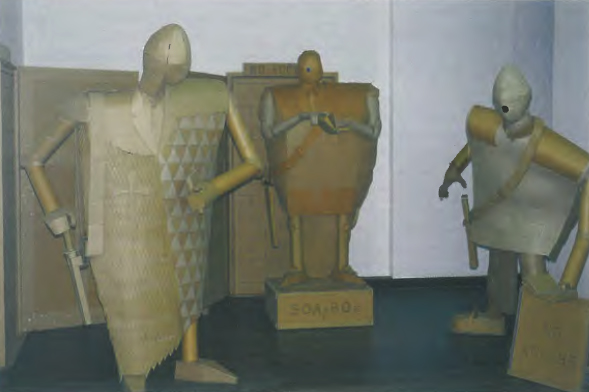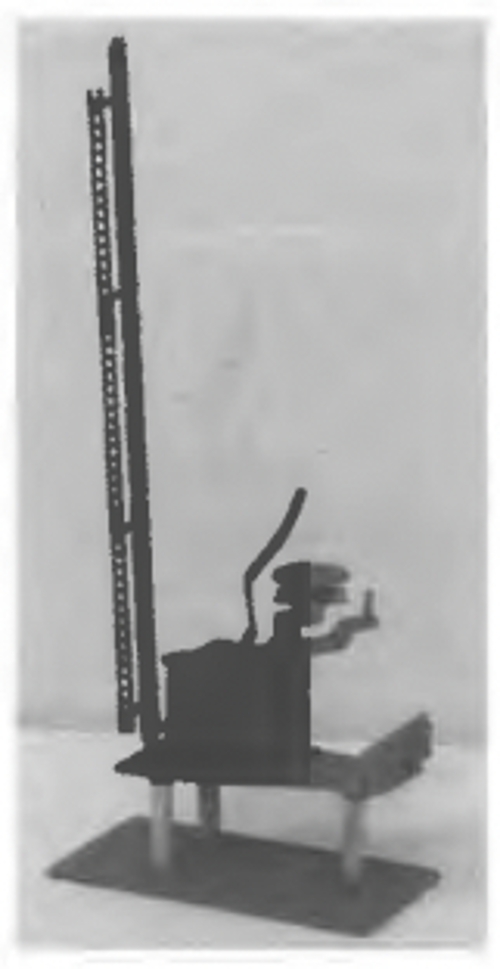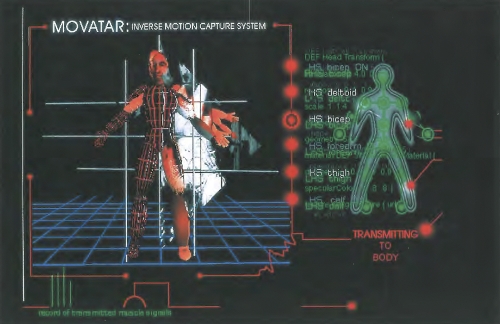
Soapbox Gallery might be described as an artist-run rental space. It is a space that is largely used by emerging artists and in recent years Soapbox has presented a solid program of work that may not always be good but is generally of interest. It is something of a miracle that Coordinator, Franz Ehmann has been able to maintain such a consistently high standard over a period of four years. Soapbox has three galleries and two window spaces which Ehmann attempts to fill with exhibitions that work together, and often they do.
On the surface Terry Summers' No access, Kim Demuth's Head-on and Sam Sexton's Full stop appear to have little in common. Summer's large cardboard sculptures of "authority" figures, Demuth's car accident carnage and Sexton's composite video installation dealing with everyday angst are thematically about as diverse as it gets. What binds these shows together, however, is their dark humour and a contradictory "home-made aesthetic" in highly crafted works. The work of each artist also immerses the audience into a twilight world where sex, authority, fear and death reign with an obsessive supremacy.
Kim Demuth's installation in which we see the aftermath of a "serious" road accident has a photographic immediacy that captures that moment of silence following a major catastrophe and before all hell breaks loose. His placement of bits of twisted metal and automobile ephemera has the eerie appearance of being an accident that is controlled by some force unknown. Objects are positioned as if they have been frozen in flight and the fresh human road kill, male and female body parts emerging from the battered car parts, suggests that the unfortunate couple may have been struck down during a moment of pleasure. This installation evokes the ghoulish pleasures of Andy Warhol's horrifying photographs of a car accident and the infamous photograph of Jayne Mansfield's severed platinum blonde head on the bonnet of her wrecked car. The comic book quality of Demuth's gruesome after image renders this installation all the more effective in challenging our propensity for laughing at what we fear while the ethical problems of inspecting the aftermath of a major smash remain unmitigated.
In a purely physical sense, Sam Sexton deliberately makes his videos difficult to watch. Three monitors placed in different parts of the room face the wall with around a metre to spare. Each is covered by a mosquito net that catches the phosphorescent glow of the screen making this a seductive work until we are compelled to move in on the video itself. Literally wedged between the wall and the screen our discomfort increases in accordance with audience numbers. In this way Sexton generates an uncomfortable intimacy between his work, the gallery and the audience.
.jpg)
All three videos waver between the amateur and the professional, the silly and the serious, clarity and obfuscation. We watch actors seemingly in the act of being themselves and Sexton's mise en scene sometimes reflects the cheap professionalism of film makers such as John Waters. As Sexton's characters go about their everyday lives in a somewhat hysterical fashion the audience is left to play the role of voyeur, trapped and struggling to make sense of the lives (and deaths) of others who via Sexton's unpretentious method of story telling, reflects their own.
Terry Summers' large cardboard sculptures of uniformed authority figures (two crusaders and a policeman) along with an impressively constructed police motor cycle and a door which is actually a brick wall might be three exhibitions in one. Summers, like Sexton, attempts to control the way the audience positions itself both physically and conceptually, in relation to the work with objects so large and imposing as to overwhelm. These figures actually interfere with the gallery space and thus the title rings true as the artist suggests that his cardboard replicas offer "no access to the body, no access to the soul, no access to the mind."
Like Demuth's smash victims, Summers' figures also have a comic book quality that ironically heightens their menacing demeanour. There is an air of megalomania about installation that derives firstly from the denotation of the figures and secondly from the way in which they are constructed. Summers, an ex-draughtsman, is well aware of his ability to create complex and difficult models and thus he also asserts the authority of the crafts person to overwhelm with both size and skill.
In her essay for Head on Courtney Pedersen might be speaking for all of the artists when she says, " & faced by Demuth's work we have to negotiate what are often very disturbing images and yet we also laugh." What is most interesting about seeing these three exhibitions together is that they incorporate what is both funny and disturbing in ways that demonstrate how this phenomenon works with differing ideas and across media. Each exhibition seduces the viewer with a tawdry kind of spectacle as it simultaneously attempts to pave the way for an experience of the work that is at times perplexing, always unsettling and shamefully amusing.












